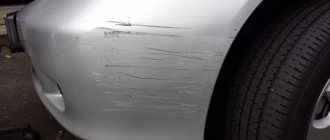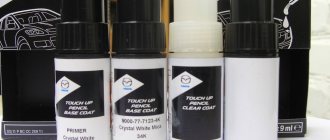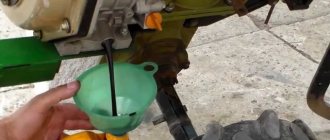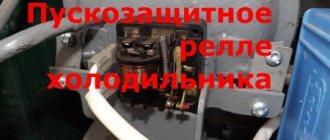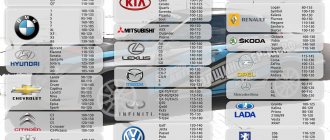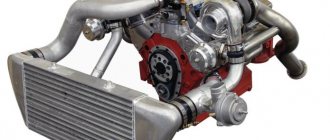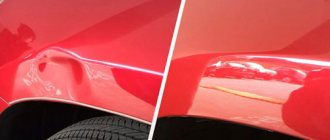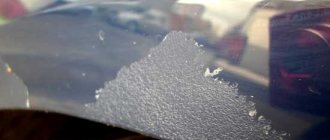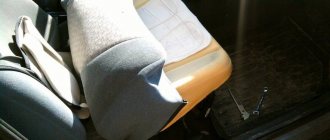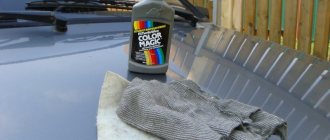Stages of work
Body corrosion can be removed only if a certain sequence of actions in this process is followed. Despite the variety of methods for repairing through corrosion with your own hands, a car enthusiast should know what to do with through body corrosion at the beginning of work. The complexity of the work itself will depend on the general condition of the car body.
Preparatory stage
First, you need to clean the surface subject to corrosion so that there is a clean piece of metal without traces of corrosion. If it is not possible to do this carefully, then the damaged fragment is cut out.
In each option for repairing through corrosion, all cleaned areas are coated with acid or epoxy primer.
Welding
From a suitable piece of metal (for body repairs of through corrosion you will need metal 0.8 mm thick), a patch is made 2-3 mm larger than the through hole. If possible, the patch is applied to the back side of the body part and, using welding, is scalded at points along the contour on the front side.
In no case should you weld with a continuous seam, so as not to lead and tighten the metal.
Welding points are cleaned flush with the repair area. This creates a depression, which is then leveled with automotive putties.
Soldering
The principle of operation is the same as when welding, but instead of 0.8 metal, tin is used (for example, cut from under a tin can). The patch is cut out slightly larger than the repair area. Using a powerful soldering iron and tin solder, the patch is soldered with a continuous seam.
The protruding sealed area on the car can be slightly recessed with a hammer, but this will complicate further work with putty, so care and precision must be observed.
Putty
For such repairs, only special automotive fiberglass putty is used. Starting from the large (starting) and ending with the small (finishing) fraction. To do this, you will definitely need a substrate (for example, a piece of abrasive sandpaper).
Each layer is thoroughly dried from 30 minutes to several hours, depending on the thickness and air temperature. The dried putty is ground with an abrasive, smoothing out the boundaries of the resulting halo.
The result is a flat surface for applying primer and paint.
The thickness of the automotive putty layer should not exceed 2 mm. Thicker layers will cause the material to crack.
Final work
Whatever method of repairing body through corrosion is carried out, cosmetic painting work will definitely be needed to complete it. This involves smoothing out the repair surface in multiple layers using several types of automotive fillers.
Each layer is dried and ground with abrasives. After this, the surface is primed with epoxy primer, then leveling. After this, the paint coating is applied.
Painting a car or its parts requires special skills, so it is best to leave it to the professionals.
Perforation corrosion is a critical defect. Not only the appearance and reliability of the car, but also the safety of its owner depends on the condition of the body. Therefore, it is advisable to regularly inspect the body and perform preventive anti-corrosion treatment.
Algorithm for carrying out the process of eliminating a through hole by applying a patch with a soldering iron
Here's what to do:
- To begin with, it is recommended to thoroughly clean the rust from the corrosive area. You can use attachments and a drill (also another set of tools).
- A patch is cut from a piece of metal sheet. An option is to use a can of auto chemicals, etc.
The patch must cover the entire hole on the vehicle frame element.
- A powerful soldering iron is prepared, with which the patch is applied.
- Now you need to tin the edges of the patch.
Particular attention is paid to the edges of the hole where the patch will be placed.
- A piece of metal is soldered with a continuous seam.
- It is checked by measuring whether the patch does not protrude above the surface of the body like a bubble.
You can diagnose the protrusion using a flexible ruler.
- The protrusion (if detected) is recessed with gentle blows of the hammer.
Once the patch is recessed, there is bound to be a small gap. It will need to be leveled using putty. We must not forget that the thickness of the putty layer should not exceed 2-3 mm. Otherwise, the layer will crack easily after drying.
- Before puttying, the surfaces are properly prepared: the rust is cleaned off with a metal brush, and then sanded.
It is better to use 120-grit sandpaper. We must not forget that the matting area should be larger than the area directly being puttied.
- An abrasive mark is applied to the surface. This is done so that the putty has something to hold on to.
- Now you need to treat all areas with a degreaser after sanding.
- The surfaces must be primed first. This is done no later than an hour after sanding, since cleaned metal without paintwork quickly undergoes oxidation processes.
It is better to take a phosphate primer as the first layer. This type of primer is a 2-component composition that is easily diluted with water.
Attention. It is prohibited to dilute phosphate primer in a metal container. The fact is that phosphate tends to interact with iron, and this is not good. It is better to use a glass or plastic container.
If you can’t find a phosphate primer, aerosol KSL primer in cans is also an option.
As soon as 10-15 minutes have passed after applying the first primer, you must proceed to treating the surface with acrylic. This type of primer is applied in 2-3 layers. The gap between layers is maintained for about five minutes.
Note. Again, acrylic primer can successfully replace the composition of an AER spray can. This is especially true if there is no compressor.
Acrylic dries completely within 3-4 hours. If it is possible to use INFR heating, the drying period can be significantly reduced.
All that remains is to putty the surface, then sand and prime.
The method of sealing a through hole using a patch is considered the most rational for a number of reasons.
- Soldered patches last much longer than just fiberglass putty.
- The patch provides a more reliable connection.
- You can close holes of almost any size (except for too large ones, when only the service of specialists is relevant).
- Simplicity of technology. Even a beginner can handle the job.
Video on how to seal a through hole
Materials for processing the underbody of a car.
Lada 2106 new life Logbook Ground wire from battery body
At the same time, if the car store you choose is not a small roadside kiosk, then the range of materials offered may simply put you in a stupor
So let's clarify what you should pay attention to here
Firstly, immediately abandon the old methods of anti-corrosion treatment based on mastic, which had to be prepared on fire according to the recipes of experienced drivers. Today, the maximum benefit from this process is the feeling of being an ancient alchemist brewing a rejuvenating remedy. Of course, such old recipes at one time somehow fulfilled the task assigned to them, but in comparison with modern means this is already a passed stage. Let me explain why.
The main disadvantage of those mastics is their tendency to crack. Because the cracks that form in such a coating accumulate road dirt very well along with the aggressive environment that is present there. And if on an untreated body such dirt is simply washed off with rainwater, then it settles very thoroughly in cracks.
Yes, and to be honest, previously there was almost nothing in car dealerships other than the usual Movil.
Well, and secondly, if you are going to do the work on the underbody of the car with your own hands, then among the range of modern anti-corrosion agents you should choose those that are provided in the format of aerosol cans (this recommendation does not apply to those who have a compressor in their garage and a sprayer that can apply an anti-corrosion compound of a given thickness). Why? The fact is that it is difficult to apply a thick layer of coating with an aerosol composition. It sounds strange, of course. But you have to understand that sometimes thicker is not better. After all, no one has yet canceled gravity and vibration, and a product applied in a thick layer, even with smudges, risks peeling off over time and exposing uncleaned body elements.
The selected means of protection against corrosion of the underbody of the car should be used strictly according to the instructions given in them, strictly observing the temperature regime of application and the operating technology. So, the requirement that the underbody of the car must be thoroughly washed before applying the product should not come as any surprise to you. This can be done today at many car washes; the main thing before carrying out the work is not to forget to wash off some of the residue.
I wish you good luck in your work, and I wish your car to forget about corrosion, although a lot here depends only on you!
Video on processing the underbody of a car
I recommend reading:
How to replace the cabin filter of a VAZ 2110?
How to adjust the handbrake?
Replacing the thermostat VAZ 2107.
Replacing rear struts on a VAZ 2114.
Tags: w202, rotten. body, sodvan, trough, trash heap
Comments 76
What is good for a Russian is bad for a German))) I think few Germans will bother about this. They have such examples on scrap metal that our Russian people will feel like a new car for the rest of their lives. I saw so many Mercs, they were all rotting. Low carbon metal. I think there is no point in doing it, the game is not worth the candle. And if you decide to do it, the money will be like new.
Because these models rot badly
Selling the car will only get worse.
Or do it but forget about winter use.
Oh, where did you get the idea that the Japs don’t rot? Any car rots, regardless of brand and nationality, with the exception of some one-off examples with garage storage, or exclusive ones made of stainless steel or carbon fiber (but I think there will also be some problems there).
Metal from LOW carbon rolled metal. From shit in general!
because nothing lasts forever, the Germans are not fools, should I sell my car and drive it for the rest of my life and not rot or break down?! and who will buy new ones then? who will buy spare parts?! especially since the car is 18 years old! It’s a sin for a man to complain about 2 things: about a woman and about a car - the eyes saw that they were taking hands)))))
Yes, you can only sell one, but the second...
in some countries you can also sell the second one =)))))
nope, a little further south and east)))
Yes, you can only sell one, but the second...
Prejudices, do whatever you want with the second one))) This is your life, and you yourself have the right to choose which car to drive and with whom to spend your life.
It’s just bad for a German in Russia)
There is enough salt in Irkutsk. Is it putty in the photo? Mercs in Europe have legendary glass rot, not to mention Russia.
It was Obama and Merkel who chewed through everything together. Are all the lights on in your entrance?)
From the 202nd body the geldings began to rot very quickly. My 202 had solid holes around the gearbox on the bottom. The car was 11 years old at that time. However, nothing was beating there. The trunk lid is also rotten to the core.
This is not an Audi so as not to rot
Yes, it doesn’t depend on the brand, but on the operating conditions. Our painters recently brought ten of them, 2001. The bumper was hit. I looked at it and couldn’t believe my eyes - there was no rust at all! Nowhere! Not the lower edges of the door, not the leading edge of the roof, not the recesses in the trunk. Not a trace of corrosion anywhere. 100 percent unpainted. We checked everything with a thickness gauge, and the shagreen was factory-made. Only the battery pad is rotten. The car was used in the village, mileage - 110,000. Such miracles happen))
Body repair without welding using aluminum mesh and fiberglass putty
Lada 2108 SofT project Logbook cylinder head repair
In this situation, there is such a rusty hole that needs to be removed, or sealed, in short, do everything to ensure that it does not exist.
1. Using a grinder or other convenient device, remove the rust.
2. Next, we take the patch and “fit it out” in place to understand how it will fit.
3. Using masking tape, attach the patch to the body.
4. Next, take fiberglass putty and apply it in a thin layer so as not to touch the tape; we will remove it later.
5. When the putty has stuck, remove the tape and continue filling the surface with the same putty.
6. We try to apply the putty in a thin, even layer, avoiding bumps. Also, if possible, we try not to increase the working repair surface, although if this does happen, then the situation can be corrected using sandpaper or a sander.
7. After the putty has dried, take a coarse-grain sandpaper (in my case it’s “120” number) and start sanding. If you have a grinder on your farm, we use it, it’s faster and more convenient.
8. After the surface is brought to a “flat and smooth” state, we proceed to the second stage - filling using automotive putty.
9. Next, we level everything again with sandpaper and prepare the surface for priming. In the photo below you can see approximately what the surface should look like when prepared for priming.
10. Next, in principle, everything is the same as everyone else’s, pour the primer into the spray gun, wrap the unpainted parts and surfaces with oilcloth, and then proceed to the primer.
11. After the surface is primed, you can begin painting.
12. On the back side of the surface to be repaired, it is also necessary to apply several layers of putty to strengthen the aluminum mesh.
13. This is what a surface repaired without welding looks like, as you can see, it turned out very well... I would like to remind haters and other skeptics once again that this is only an alternative repair option, for those who do not have welding or the desire to tinker with it. If you need higher-quality body repairs and you have the money for it, do not be lazy and entrust your car to professional tinsmiths, who will not only remove the rust and weld the hole efficiently, but also restore the paintwork of your car to its original appearance.
That's all for me, if you don't understand something, I recommend watching the video below, in it the process of body repair without welding is described and shown more clearly
Thank you for your attention and for visiting VAZ Repair
Fixing a hole in a car body without the help of a welding machine
It sometimes happens that before repainting the car, the driver encounters one unfortunate obstacle. Layers of paint have been removed, and there are gaping holes in the body of the car. Naturally, many will turn to a specialist to have these holes repaired by a professional. True, such work will not be cheap.
But there is another way. You can do everything yourself. This option is good if the hole is not very large, about the size of a cork. In this case, you can try to cope with this problem without resorting to the expensive services of a body mechanic. Although if the hole is quite large, then, of course, you cannot do without the help of a specialist.
Option one
This method is simple, but it has its negative consequences. To get rid of a through hole, you need to add fiberglass to the putty and seal the hole. This can be done easily and simply, and most importantly quickly, but this solution to the problem is short-lived. Over time, water will cause the covered area to begin to deteriorate again. So for a more thorough body repair, it is better to use the following method.
Option two
In the second option, you will need a piece of any metal. You should cut a patch of the required size from it, just make sure that the patch completely covers the hole. Then you apply the patch to the hole and use a soldering iron and flux to solder it.
Before you start soldering, you need to tin the place to which this patch will be soldered. You should also tin the edges of the patch itself. And when you solder the patch, be sure to wash all treated areas with flux.
After you have soldered the patch, see if it protrudes above the general surface. If it is convex, then you need to use a hammer to level it and you can even bend it a little. Once you have leveled the patch and made a small dent, you can consider the first phase to be complete. Then this recess will be leveled with putty.
When applying the putty, keep in mind that you should not apply more than 3 mm.
To prepare the surface for puttying, you will need 3M sandpaper or something like Mirka with an abrasive surface of about 120.
Now we clean the required surface in a circular motion. This must be done so that the putty adheres better. After cleaning, degrease the surface with a rag soaked in White Spirit, and also remove dirt and dust.
Primer
Next, as is already clear, comes the primer. The metal surface quickly oxidizes and becomes rusty. And the faster the primer is applied, the better it will be. From personal experience I will say that it is better to use two types of soil. The first is phosphate, and the second is two-component acrylic. The phosphate layer dries out quite quickly, so it needs to be applied quickly and only once. It is applied immediately to the metal surface in a thin layer. After this, when the phosphate layer has dried, apply the acrylic layer. It should be applied several times, maybe 2 or 3 times with an interval of 5-10 minutes.
If you do not have a compressor for spraying, you can use aerosol cans. It all dries in about 2 or 3 hours. If you use infrared heating, the time will be shortened and everything will dry in 20-30 minutes.
These are all general tips on how to patch a hole in the body yourself. Now you can get to work. And if you use the second option, then such a patch will last another five years.
tdsmotors.ru
Wing arch repair using welding
Lada 2110 AGRESSOR Logbook Repair of power window control unit
I will show the example of repairing the rear wing of a Golf 2. I am showing an example, the quality is 4, because the car is for sale, with clients everything is a little different. To begin with, all the plasticine was picked out, which the previous owner used to repair the hole in the arch :) After which, the rottenness was cut out with a grinder to the living metal, the edge was cleaned for welding. After the outer part of the arch was cut out, it turned out that the inner part was also slightly rotten.
Putrefactive areas cut out
After that, repair inserts were made, first welding the inner part.
Welded insert for the inner part of the wing arch
The seam was sanded in several places, where it made it difficult for the outer insert to lie flush. After which the outer part was welded.
Welded external repair part of the wing arch
I note that during manufacturing and welding, the repair insert needs to be recessed slightly below the level of the entire arch; this will allow you to perfectly display the entire geometry of the arch. The seam was sanded and puttied. Everything was removed quickly using an eccentric grinder; I will publish a review of it in the future. The putty used was Gold Car with duralumin filler, it’s not a bad putty, it applies and sands well. After sanding was completed, everything was primed with acrylic primer and painted with a metallic color, Quartz.
https://youtube.com/watch?v=OnpuSiCKfdo
A quick and reliable method of body repair
no welding. The strength of the material is very high. If the basis.
Arch after coloring
Repaired putrid arch
To make your work easier and to add some additional material, watch the video below, it shows how to remove the wing arch with putty.
Also new from this post is a post in video format! Watch it, subscribe!
Body repair of UAZ-452,-3303. Video
Body repair
UAZ-452,-3303.
Repair
of rotten body with metal plates. Video
For such repairs you need:
- Disassemble and clean the body;
- Cut off areas with corrosion;
- Weld metal plates;
- Prime and paint the body.
How to repair the body of a UAZ-452, -3303? Let's talk a little about the characteristics, configurations and modifications of our unit:
- A gasoline engine with a displacement of 2.445 liters and a power of 92 hp is installed on board the UAZ. The engine is produced either at the Zavolzhsky or Ulyanovsk Motor Plants.
- an all-metal cabin with two seats and two side doors.
- transmission. It has a single-disc clutch and a hydraulic release drive, a 4-speed gearbox. Each forward gear has synchronizers. The transfer case has 2 stages. There are also two cardan gears, each of them consists of one shaft.
- Disc wheels are mounted on five studs. Tires and universal tread pattern. Wheels with 16 discs are currently being installed
- The suspension is characterized by dependent front and rear gears, and has two shock absorbers on each axle.
- The braking system is two-circuit, has a hydraulic drive and a vacuum booster. Regarding the parking brake, transmission with fur. drive.
- tank volume is 56 and 30 liters, recommended gasoline is A-76. About 14 liters of coolant are needed for the cooling system.
It is worth noting that various modifications of our car brand may have wooden or metal platforms. When we have become familiar with the characteristics of the car, we can proceed directly to repairing the body, more details in the video on repairing the body of UAZ-452,-3303:
- to begin with, we disassemble and clean the body of various debris and rust;
- we clean, and if necessary, we cut off areas with corrosion of the body;
- We weld metal plates, taking measurements in advance;
- We prime and paint our body.
The description was compiled by Ivanov A.I.
Posted date: 09/13/2012, 12:15
Restoring a car after minor damage Treating a car with anti-corrosion materials VAZ 2112: how to repair the body with your own hands (video) UAZ-452, UAZ-3303: how to repair the body in an hour (video)
Stages of corrosion treatment
Preparatory work
Washing and drying
Anticorrosive treatment involves preparatory work, which must begin with a mandatory car wash. Plain water and a washing brush will not help much in this case. It is best to do this at a specialized car wash, because you can thoroughly wash the dirt from below only on a lift, and the water must be warm and under pressure. If you do this yourself, you need to stock up on steel brushes of various diameters, a grinder and a drill. By the way, washing a car should be done with the wheels removed.
The next step in preparing the car for anticorrosive treatment is drying. It is also better to do this in a special sink using forced hot air. At home, the car should be left to dry in a closed garage for at least a day.
Inspection of the bottom and all hidden surfaces to determine the scope of work
Inspecting the underbody of the car involves driving into a pit or, best of all, onto an entry ramp. To establish the scope of work, you need to prepare the following tools:
- screwdriver for scraping;
- putty tool for removing hanging elements;
- wire brushes for cleaning old corrosion;
- a lantern or table lamp to illuminate dark corners;
- a hand mirror for inspecting the insides of nooks and crannies.
Main types of work
Cleaning the bottom
To clean damaged areas of the underbody of the car, you can use the following tools:
- drill,
- cleaning gasoline,
- sanding paper,
- washing brush for degreasing,
- hair dryer,
- sticky sealing paper.
Application of drugs
In areas of the defect where there is no corrosion yet, you can simply apply an even layer of protection. Rusted elements should first be cleaned of rust and treated with a neutralizer. After it dries, protection should be applied.
Anticorrosive treatment of the underbody of a car includes the following steps:
- processing of wheel arches;
- processing of fasteners, bolt connections;
- processing of suspension elements;
- processing the inside of the hood;
- processing of ball joints;
- processing of welds.
Since the anticorrosive agent is applied evenly in the centers thanks to the method of air spraying under pressure, for better treatment of the underbody of the car you should use a brush, and if you have one, it is better to use an airless spray gun. In hard-to-reach places, it is worth using special flexible nozzles, which are sold complete with an anti-corrosion agent. Anti-corrosion treatment is applied in two layers.
When treating with anticorrosive you should be careful. If the protection gets on the drive belts, generator or radiator honeycombs, this will cause them to slip, resulting in poor engine cooling.
Final stage
After completing all the work, you need to thoroughly clean all the windows and mirrors of the car using special products, and also thoroughly wipe all other surfaces.
Video about anti-corrosion treatment of a car:
https://youtube.com/watch?v=MDm3NhFYBtE
Every car needs anti-corrosion treatment, which begins to age from the moment it leaves the tape. The corroded underbody and all hidden parts especially need protection. But in addition to anti-corrosive treatment, keeping your car clean and free of dirt and grime will be the most reliable way to avoid rust and corrosion. How do you protect your car from the adverse effects of chemicals?
Repairing rotten areas of the door
As we have already found out, when play appears in a certain place of the door, corrosion most likely occurs. Almost no air gets there, so the door begins to rot from this part. Corrosion destroys metal from the inside, so it can be difficult to notice at first. The principle of repairing rotten door sections is the following procedure:
If the door is very rotten, you can also try to restore the rotten parts. However, this will require much greater financial and time costs, so in some cases it will be more expedient to replace completely rotten doors - especially if you are using a car from a domestic manufacturer, because their price tags for body parts are not very high.
What is car anti-corrosion treatment?
Anticorrosive treatment provides protection against rust and protects the car surface from the negative effects of chemically active substances. Other benefits of anti-corrosion treatment include the following:
- Applicable for all types of machines.
- Aging resistant, heat sealable, odorless.
- Durable, easy to clean, dries quickly.
- Abrasion resistant.
- Flexible when exposed to low temperatures.
- Keeps the surface sterile and clean from bacteria and pathogenic organisms.
- Protects against water and thus prevents oxidation.
- Excellent resistance to UV rays and cracking.
- Not hazardous to health.
Patch made of thin tin
- Now you need the same hammer soldering iron, with its help you will have to tin the surfaces on the outside of the hole and the edge of the finished patch with tin;
- Soldering acid or its analogue is used as a flux;
- At the end, the patch will need to be soldered with a continuous seam, then the patch will need to be hammered down;
- Clean the protruding edges with coarse sandpaper;
- After this, cover the defective area with putty, prime and paint;
- Body repairs after rust can be done by welding;
- The patch is welded to the body using carbon dioxide welding, but for this you will need a welding machine (or a welder with a machine), plus welding skills;
- Further processing as with the previous patch, stripping, primer, putty, sanding the putty and painting;
- Don't forget about processing the reverse side.
We wish you success in your body work!
- Absolutely legal (Article 12.2.4).
- Hides from photo and video recording.
- Installs independently in 2 minutes.
- Invisible to the human eye, does not deteriorate due to weather.
- 2 year warranty
When to treat with anticorrosive
It will be better if anticorrosive treatment is carried out for all cars. Factory protection in the form of anti-noise plastisols can only protect the metal from mechanical stress, which can subsequently cause corrosion.
For old and used cars, anti-corrosion treatment is recommended periodically every two years. This treatment can be carried out in special anti-corrosion centers or independently. True, the price for processing by specialists is quite high.
As the machine ages, small displacements appear in the welding seams, reducing the tightness of the parts and destroying the applied protection. In addition, the protective layer is destroyed by small pebbles, ice, sand, chemicals, and dirt. As a result of such processes, the car begins to rust, especially the bottom and all hidden cavities.
Anticorrosion protection of a car should also be carried out after repairing or replacing body parts.
Repairing a rotten wing arch
The car body usually begins to rot from closed cavities, the sills, side members, and wheel arches suffer. We will now talk about the latter, more precisely about their repair.
Repair rotten
wing arches
When repairing cars produced by VAZ, it’s quite a common thing - I bought an arch repair insert, welded the whole thing or putty on a piece, etc. But when repairing foreign cars, difficulties arise - repair inserts are either very expensive, or you have to wait a month for delivery, or they don’t exist at all. This is where the difficulties begin, how to repair a putrid arch
Let's start with the options for repairing the arch, and I know few of them, just a couple:
- Repair
using putties, fiberglass - Repair by welding
They can also be immediately divided - the first is the least high-quality, the second is more high-quality, reliable and predictable in terms of results. Briefly about each.
The first method of repairing a rotten wing arch is to clean off the rust, restoring the geometry of the arch using putty with fiberglass or fiberglass impregnated with epoxy. Also, before applying the above components, it would not be superfluous to treat the rusty areas with reactive or epoxy primer; they will stop the rust.
Attention! You cannot put putty on reactive primer; it must be covered with acrylic or primer filler!
The hole is sealed, after drying it is sanded, the geometry is removed with a two-component putty, you can use universal putty, duralumin putty, etc. But this is not a high-quality repair, because in practice it can last either one day or one year - the result is not predictable, and the costs are comparable to the next option.
Repair of large-scale damage
In extreme cases, medium-sized holes can be quickly filled with putty, but instead of a lining, a metal mesh is secured on the other side. It will ensure uniform spreading of the composition and serve as reinforcement. A stronger and more durable patch is made from fiberglass.
Several overlays are cut out of it in accordance with the size of the damage, adding 2 cm on all sides. After applying the epoxy glue, they are applied in layers to the damaged area. To prevent sagging, a lining is placed. The quality of a fiberglass patch largely depends on the accuracy of the technology. Therefore, it is better to use ready-made plastic, for example, textolite 3 mm thick. The patch is secured with epoxy glue, but it would be a good idea to reinforce it with aluminum rivets. The cathodic protection they create will create a barrier to corrosion.
For significant damage, iron and aluminum sheet material patches are applied. They are overlapped with an overlap of at least 2 cm onto the metal of the bottom. The fastening can be bolted, but it is better to use aluminum rivets in combination with epoxy resin. Especially for patches made of iron, the composition of which is unknown. The resin used as an inhibitor (a substance that slows down processes) will protect against electrochemical corrosion.
Application of fiberglass and glue
For moderate damage, the method of sealing holes with fiberglass is often used. When this area has been processed and cleared of layers of paint and rust, it is necessary to cut several overlays from fiberglass, the size of the hole plus 2 centimeters. This area should be pre-primed and allowed to harden.
Auto repair kit
An overlay is applied to the dry surface and secured with a mixture (polyester or epoxy resin + glue). The next “part” is applied and also fixed. Thus, all the fiberglass parts are glued, placing them one on top of the other. To prevent them from sagging or deforming, you should put a lining. When the resin and glue have dried, you need to treat the work area and paint it.
Fiberglass
Installation of galvanizing and riveted connections
Processing holes in the bottom of a car with galvanized metal is quite common. The main material required for this is iron sheet. Before installation, it should be secured with self-tapping screws and lubricated with mastic. It is best to use an anti-noise bitumen mixture. The galvanized sheeting is then laid and bolted in place using a drill. Then you need to treat the area with special means and level the entire surface. When everything dries and the structure is fixed, it should be coated with paint.
https://youtube.com/watch?v=xug-dOUT16E
Another reliable option for filling holes is to make rivet joints. Using this technology, large and small holes can be eliminated. To do this, the damaged area is cut out and the edges are cleaned of paint and rust. Next, steel rivets are cut out, since they are least susceptible to corrosion. Then the part is applied and secured with these rivets. When the structure is completed, the entire area is painted.
Pneumatic riveter
So, there are several ways to repair holes in the bottom of a car without welding. You can use any method described in this article. Choose exactly the option that you can implement. And remember, it is possible and very pleasant to carry out any task on your own.
Soldering a metal patch
Soldering a metal element to a damaged area is a way to seal holes in the bottom or any other part of a car when you can close a small hole. To repair a machine using this technology, you must have the following tools:
- a piece of metal sheet;
- powerful soldering iron;
- flux or rust converter;
- putty;
- primer.
Materials in the car
So, first, the area that needs to be repaired is cleaned, paint, rust, and dirt are removed. Next, it is treated with flux and degreased. Then measurements are taken and a metal piece of the desired shape is cut out. Such an element will completely seal the hole, and the edges will overlap. When the part for the patch is ready, it is attached with a soldering iron. Then the edges of the patch are treated with flux. Finally, it is worth treating the area with putty and priming it. When the surface is dry, paint and a protective layer are applied.
This method of filling holes in the bottom of a car is the most popular. Experts note the durability of the soldered patches, since the connection is quite reliable. In addition, this method can be used to seal a hole of any size. In general, soldering a patch is quite simple, and even a beginner who does not have much experience in car repairs can handle it.
Sequence of actions when sealing holes in the bottom
Detection of rotten areas of the body
Some rotten elements of the frame are not particularly difficult to detect - you open the car door and see that it has rotted at the bottom along with the threshold. However, rust has a nasty tendency to hide, and sometimes it can be difficult to find.
Detecting rusted areas of the threshold will also not cause much difficulty - a visual inspection is carried out to look for spots of rust. And if even the slightest areas of corrosion are detected, it is recommended to restore the worn area, otherwise the rust will continue to eat everything.
Sometimes access to the inside of the threshold is hidden by molding
- in this case it must be removed, and in some cases you will see that a significant part of the metal has been destroyed.
Methods for filling holes in the bottom of a car
Corroded places in the car are revealed during external inspection when placing it in a pit, for example, for prevention. They look like swellings and crumble when you try to remove them, revealing holes. Then you need to remove the floor covering, evaluate the size and number of holes and determine how to seal them. Can be used:
- putty;
- a patch made of metal or plastic;
- epoxy resin;
- fiberglass combined with glue;
- rivets;
- sheet metal.
To prevent corrosion from spreading further, you need to remove rusted metal residues and, using sandpaper and a metal brush, clean the edges of the damage to a shine. The surface is then treated with a corrosion converter. After patching the holes, bitumen mastic for cars, putty or paint is applied to the metal next to them. The procedure is performed on both sides of the bottom.
Repairing large-scale damage
Any hole in the threshold of a car indicates the beginning of corrosion, but what to do if the destruction of the metal is large-scale and simple means cannot be avoided? In this case, a gas welding machine is required, a complete digestion of the body, and sometimes a complete replacement of parts of the bottom and wings.
Superficial repairs using putty, fiberglass, and small metal patches will not change the situation dramatically; rotting of the body will continue.
Many car enthusiasts are faced with the problem of minor body repairs, when they do not have enough funds to contact a specialized car service or they want to carry out all the work themselves. If earlier owners of used cars, whose age was estimated at tens of years, thought about this issue, then with modern traffic density, auto repair threatens even relatively new vehicles. The fact is that you have to fight not only with local areas of rust on the body. The sharply increased number of minor accidents also puts new cars at risk.
Epoxy resin acts as a suitable and affordable means for auto repair. There are no strictly established instructions for its use, but there are plenty of life hacks on the Internet where epoxy is used. Later we will tell you which brands of resins are suitable for this purpose. But since fiberglass is an indispensable component when working with epoxy resin, you should first pay attention to this composite material, describing its features and properties.

